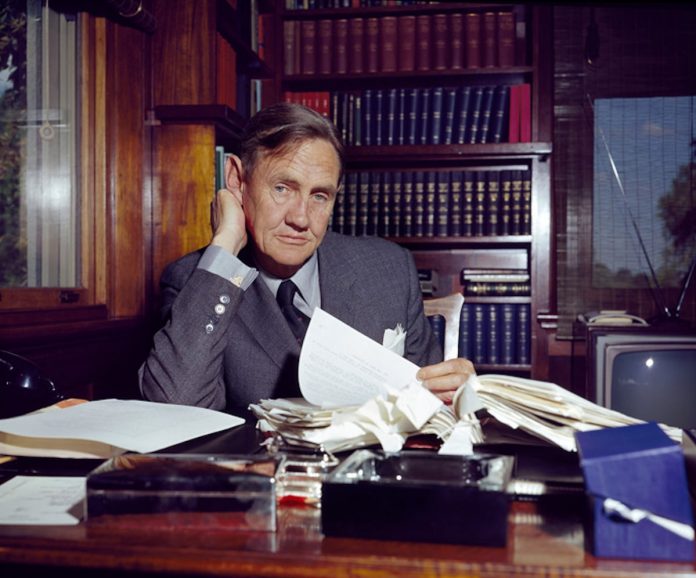Fifty-two years ago, one of Australia’s most fascinating characters rode into the public spotlight, leading us journalists on a tumultuous, three-year adventure.
And, beneath it all was the biggest story of all, unknown to anyone. John Gorton may have been our illegal Prime Minister.
Gorton set a benchmark for Aussie mystery, larrikinism, sheer guts and survival.
Australia’s unlikely PM, who served in 1968-1971, was born out of wedlock in conservative 1911, had no birth certificate and an uncertain birthplace. A wartime fighter pilot, he was shot down and when rescued, his ship was torpedoed by the Japanese.
But John Grey Gorton was far from sunk.
I joined Gorton’s (he wasn’t Sir John yet) media entourage for his prime ministerial opening of Esso-BHP’s plant at Victoria’s Long Island Point in 1970. At lunch, we all received a now politically incorrect, silver cigarette lighter.
Gorton had a warming look with a perpetual smile on his open, battle-scarred face. Once met, women and men were attracted by his smile, soft speaking manner and keen listening ability.
He famously voted himself out of office but we now know that he may not have been even eligible to stand for office.
With no birth certificate, his date of birth on official forms shows 9 September, 1911, in Wellington, New Zealand. But his birthplace, as registered in documents in Victoria, shows Melbourne.
There were also inaccuracies: His name given as John Alga Gordon, his unwed parents were recorded as husband and wife, his father’s name was incorrect and his sister was recorded as deceased.
Gorton’s father told him that he was born in Wellington and Gorton listed Wellington on his RAAF enlistment papers. This would have made him a New Zealand citizen from 1 January 1949 and dual-citizenship would have rendered Gorton ineligible to sit in Australia’s federal parliament.
With his parents frequently away on business, Gorton lived with his maternal grandparents in Melbourne until, at age four, he went to live with his parents in Sydney.
At age eight, his mother contracted tuberculosis, was sent to a sanatorium and died, aged 32. Gorton lived with his father’s estranged wife, Kathleen, where he met his sister, Ruth, having been told she was dead.
Gorton boarded at Sydney Church of England Grammar School, went on to Geelong Grammar, became a school prefect and house captain and represented the school in athletics, football and rowing.
His father took out a second mortgage to allow Gorton to attend Oxford University.
He also took flying lessons and got a pilot’s licence. On holiday in Spain, he met his future wife, American Bettina Brown.
When his father died in August 1936, Gorton took over managing his orchard.
Elected to the Senate in 1949 under Robert Menzies and then Harold Holt, Gorton held several portfolios.
In Australian political history’s most dramatic circumstances, Gorton became PM after Harold Holt was washed out to sea and lost, on 17 December 1967. Gorton was the only senator to assume the office of PM, before switching to the House of Reps.
Amid growing public discontent at the Vietnam War, Gorton began withdrawing troops. Ahead of his time, by 47 years, in 1973 Gorton introduced a motion in Parliament calling for the decriminalisation of homosexuality.
After Malcolm Fraser turned against Gorton, he called a caucus meeting. A motion of confidence was tied and he could have remained in office but he said: “That is not a vote of confidence, so the party will have to elect a new leader.”
Billy McMahon was elected.
In World War II, Gorton enlisted in the RAAF. Too old at 29 for pilot training, he re-applied after the rule was relaxed, trained as a fighter pilot and was posted to Britain.
In a dogfight over the South China Sea, his engine failed and he landed on Bintang island, south east of Singapore. The plane flipped, Gorton’s nose was smashed and mutilated, his cheekbones broken and both arms badly slashed. But he was rescued by the Royal Dutch East Indies Army.
His face was so badly mutilated that an RAF staffer sent to collect him assumed he was near death, collected his personal effects and returned to Singapore without him.
Then, on an ammunition ship torpedoed outside Jakarta, Gorton found himself on a crowded life-raft, in shark-infested waters and with little drinking water until rescued by HMAS Ballarat.
Finally, he was on a ship to Fremantle, with seriously-infected arms needing treatment but more worried about the affect his mutilated face would have on his wife, Betty.
Sir John Gorton died at Sydney’s St Vincent’s Hospital in 2002, aged 90. He was cremated and his ashes interred at Melbourne General Cemetery.


































